Ismail M., Koelink E. (editors) Theory and Applications of Special Functions
Подождите немного. Документ загружается.

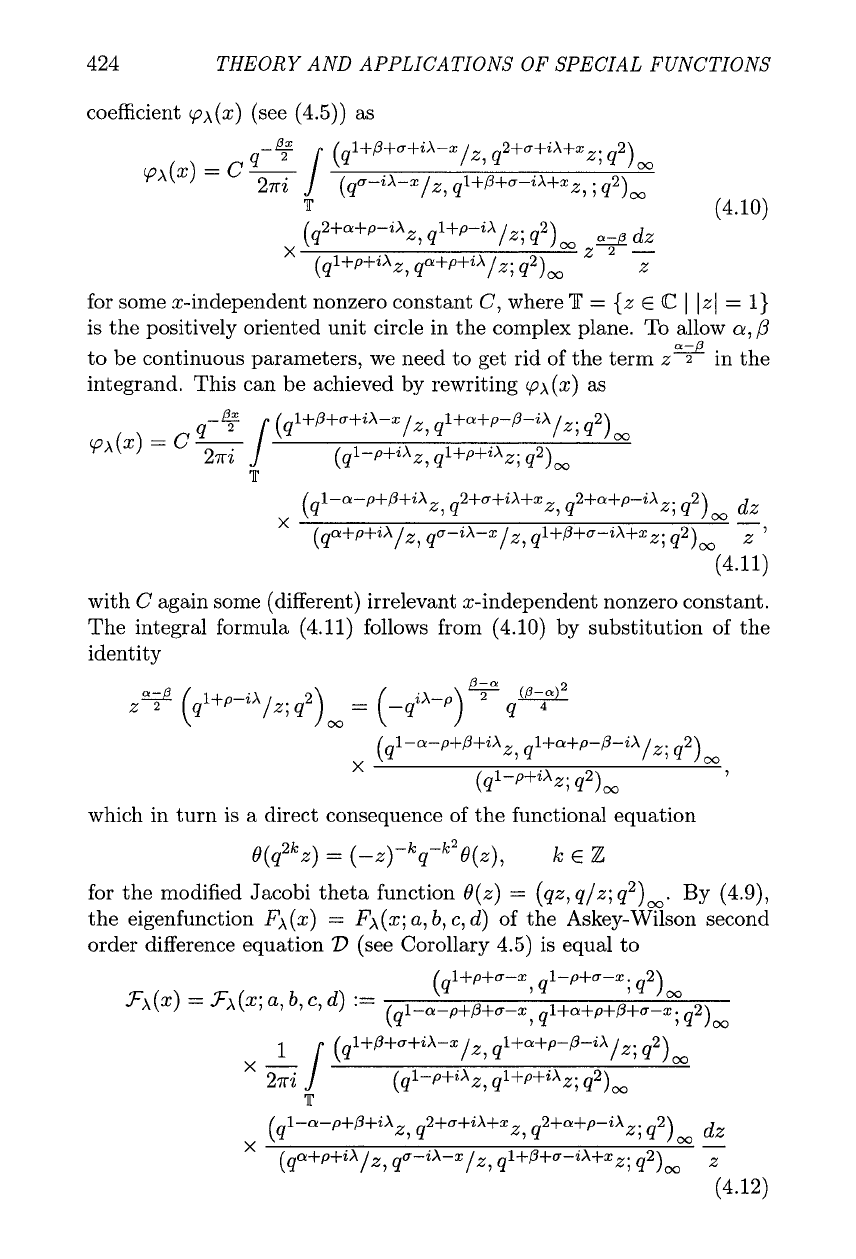
424
THEORY AND APPLICATIONS OF SPECIAL FUNCTIONS
coefficient cpx(x) (see (4.5))
as
for some x-independent nonzero constant C, where
T
=
{z
E
C
I
lzl
=
1)
is the positively oriented unit circle in the complex plane. To allow
a,
P
to be continuous parameters, we need to get rid of the term z%@ in the
integrand. This can be achieved
by
rewriting cpx(x) as
with C again some (different) irrelevant x-independent nonzero constant.
The integral formula (4.11) follows from (4.10) by substitution of the
identity
which in turn is a direct consequence of the functional equation
for the modified Jacobi theta function Q(z)
=
(az, q/z;
a2),.
By (4.9),
the eigenfunction FA(%)
=
Fx(x; a,
b,
c, d) of the Askey-Wilson second
order difference equation
2)
(see Corollary 4.5) is equal to
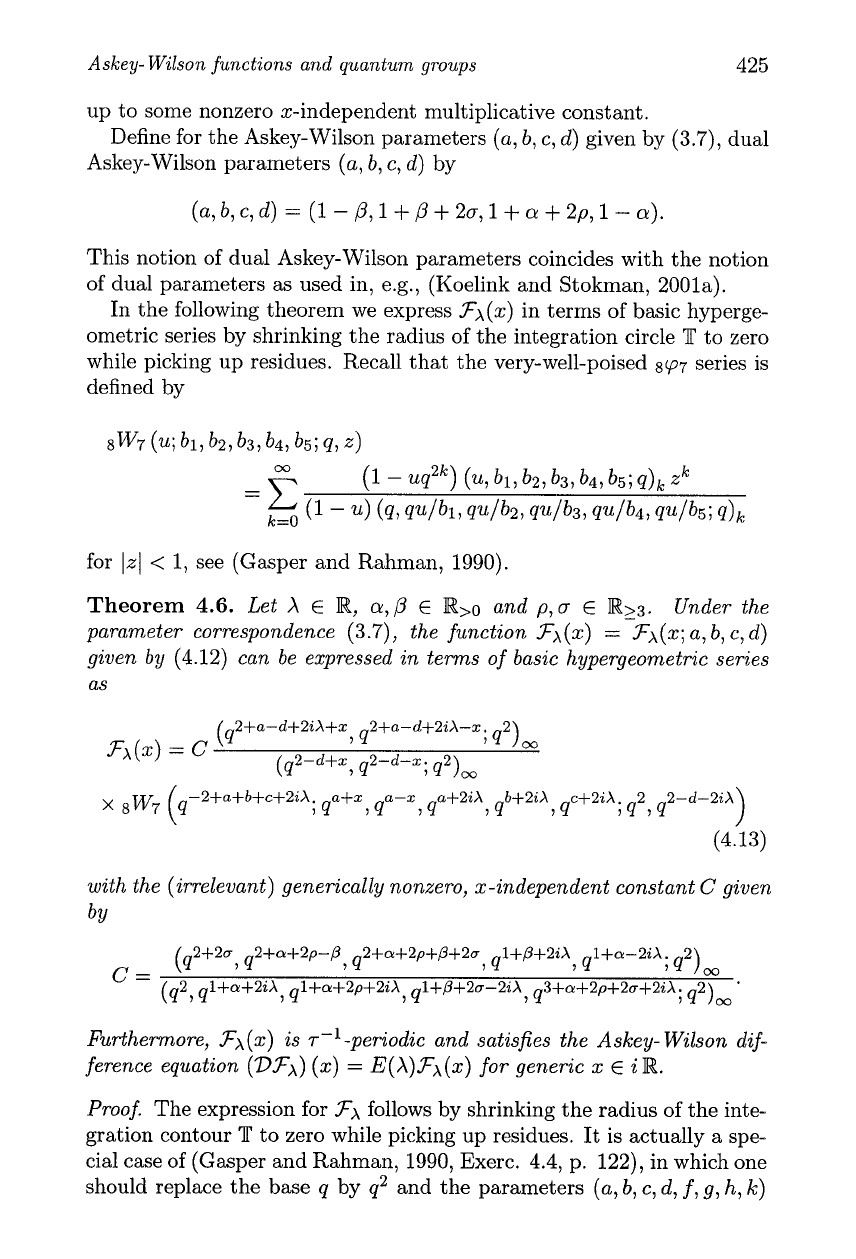
Askey- Wilson functions and quantum groups
425
up to some nonzero x-independent multiplicative constant.
Define for the Askey-Wilson parameters (a, b, c, d) given by (3.7), dual
Askey-Wilson parameters (a,
b,
c, d) by
This notion of dual Askey-Wilson parameters coincides with the notion
of dual parameters as used in, e.g., (Koelink and Stokman, 2001a).
In the following theorem we express Fx(x) in terms of basic hyperge-
ometric series by shrinking the radius of the integration circle
T
to zero
while picking up residues. Recall that the very-well-poised
s(p7
series is
defined by
for lzl
<
1,
see (Gasper and Rahman, 1990).
Theorem
4.6.
Let
X
E
R,
a,P
E
IR>O
and p,a
E
R>3.
Under the
parameter correspondence (3.7), the function .FA(x)
=
-FA
(x; a,
b,
c,
d)
given by (4.12) can be expressed in terms of basic hypergeometric series
as
with the (irrelevant) generically nonzero, x-independent constant
C
given
by
Furthermore, FA(x) is ~-l-~eriodic and satisfies the Aslcey- Wilson dif-
ference equation (27.F~)
(x)
=
E(X)FA(x) for generic x
E
i
R.
Proof. The expression for
FA
follows by shrinking the radius of the inte-
gration contour
T
to zero while picking up residues. It is actually a spe-
cial case of (Gasper and Rahman, 1990, Exerc. 4.4, p. 122), in which one
should replace the base q by q2 and the parameters
(a,
b,
c,
d,
f,
g,
h,
k)
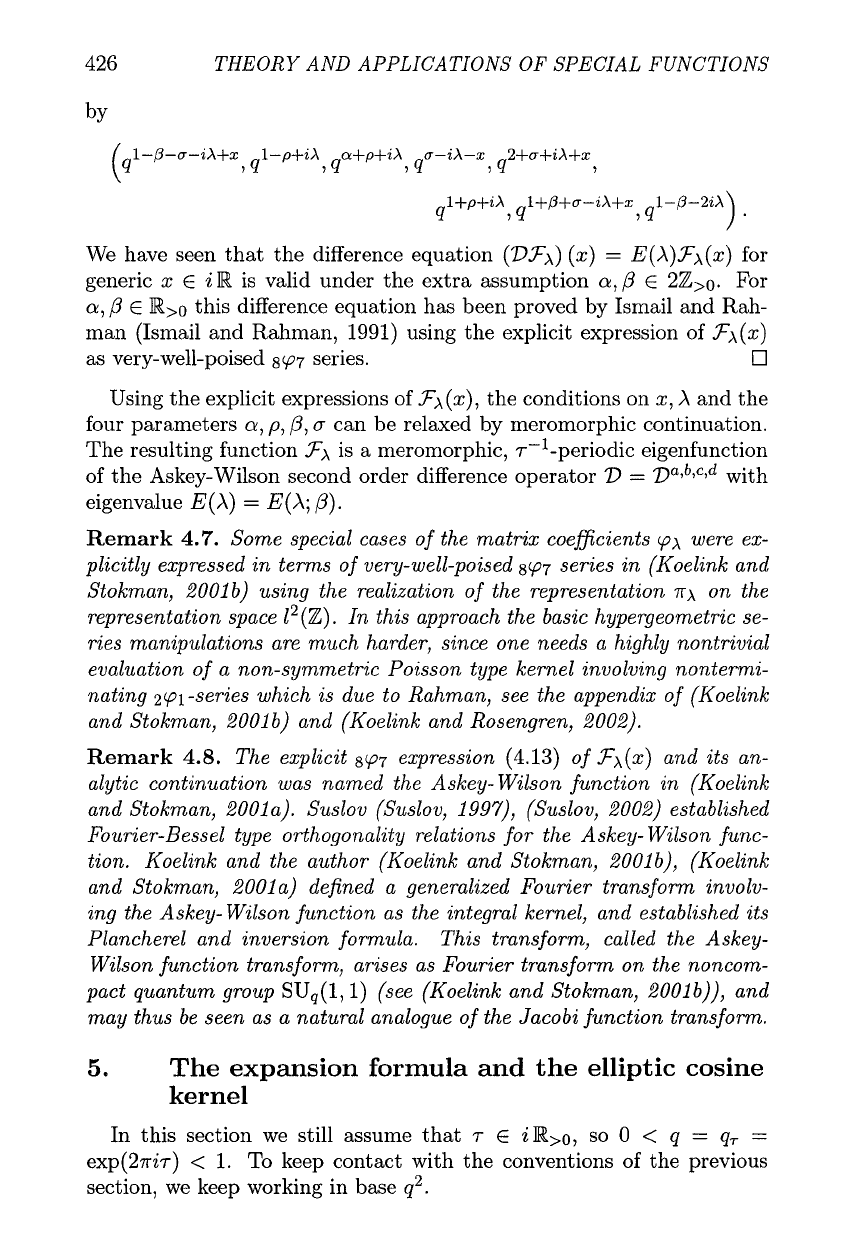
426
THEORY AND APPLICATIONS OF SPECIAL FUNCTIONS
We have seen that the difference equation (DFA) (x)
=
E(A)FA(x) for
generic x
E
i
R
is valid under the extra assumption
a,
P
E
2Z>o. For
a,
p
E
this difference equation has been proved by Ismail and Rah-
man (Ismail and Rahman, 1991) using the explicit expression of FA(x)
as very-well-poised
8(P7
series.
0
Using the explicit expressions of FA(x), the conditions on x,
X
and the
four parameters
a,
p,
p,
a
can be relaxed by meromorphic continuation.
The resulting function
FA
is a meromorphic, ~-'-~eriodic eigenfunction
of the Askey-Wilson second order difference operator
D
=
D~*~*~,~
with
eigenvalue
E
(A)
=
E
(A;
P)
.
Remark
4.7.
Some special cases of the matrix coeficients
(PA
were ex-
plicitly expressed
in
terms of very-well-poised
S(P7
series
in
(Koelink and
Stokman, 2001b) using the realization of the representation
.rrx
on the
representation space l2(2). In this approach the basic hypergeometric se-
ries manipulations are much harder, since one needs a highly nontrivial
evaluation of a non-symmetric Poisson type kernel involving nontermi-
nating 2pl-series which is due to Rahman, see the appendix of (Koelink
and Stokman, 2001 b) and (Koelink and Rosengren, 2002).
Remark
4.8.
The explicit
897
expression
(4.13)
of
FA(x)
and its an-
alytic continuation was named the Askey- Wilson function in (Koelink
and Stokman, 2001a). Suslov (Suslov, 1997), (Suslov, 2002) established
Fourier-Bessel type orthogonality relations for the Aslcey- Wilson func-
tion. Koelink and the author (Koelink and Stokman, 2001b), (Koelink
and Stokman, 2OOla) defined a generalized Fourier transform involv-
ing the Askey- Wilson function as the integral kernel, and established its
Plancherel and inversion formula. This transform, called the Askey-
Wilson function transform, arises as Fourier transform on the noncom-
pact quantum group
SUq
(1,l)
(see (Koelink and Stokman, ,2001 b)), and
may thus be seen as a natural analogue of the Jacobi function transform.
5.
The expansion formula and the elliptic cosine
kernel
In this section we still assume that
T
E
ilW>o, so
0
<
q
=
q,
=
exp(2ri~)
<
1. To keep contact with the conventions of the previous
section, we keep working in base
q2.
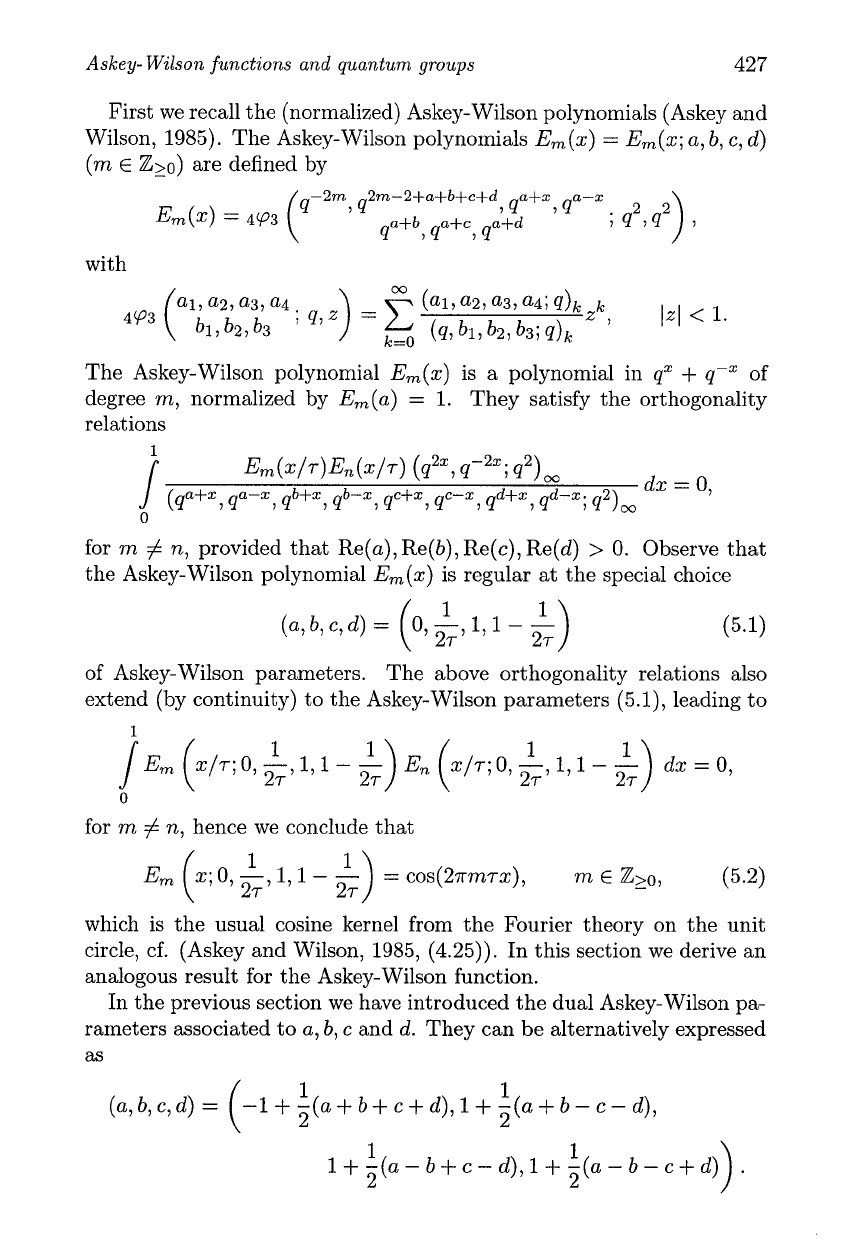
Askey- Wilson functions and quantum groups
427
First we recall the (normalized) Askey-Wilson polynomials (Askey and
Wilson, 1985). The Askey-Wilson polynomials Em(x)
=
Em(x; a, b, c, d)
(m
E
Z>o)
-
are defined by
with
CO
al, a2,
a3,
a4
(~1,
a21
a31
a4; qh
,k
I,[
<
4V3
(
hib21b3
;
'")
=
k=O (q,
bll
h1
b3;
q)k
'
The Askey-Wilson polynomial E,(x) is a polynomial in qx
+
q-" of
degree m, normalized by Em(a)
=
1. They satisfy the orthogonality
relations
for m
#
n,
provided that Re(a), Re@), Re(c), Re(d)
>
0.
Observe that
the Askey-Wilson polynomial Em(x) is regular at the special choice
of Askey-Wilson parameters. The above orthogonality relations also
extend (by continuity) to the Askey-Wilson parameters (5.1), leading to
0
for m
#
n,
hence we conclude that
=
cos(2~m~x), m
E
Z>o, (5.2)
which is the usual cosine kernel from the Fourier theory on the unit
circle, cf. (Askey and Wilson, 1985, (4.25)). In this section we derive an
analogous result for the Askey-Wilson function.
In the previous section we have introduced the dual Askey-Wilson pa-
rameters associated to a,
b,
c and
d.
They can be alternatively expressed
as
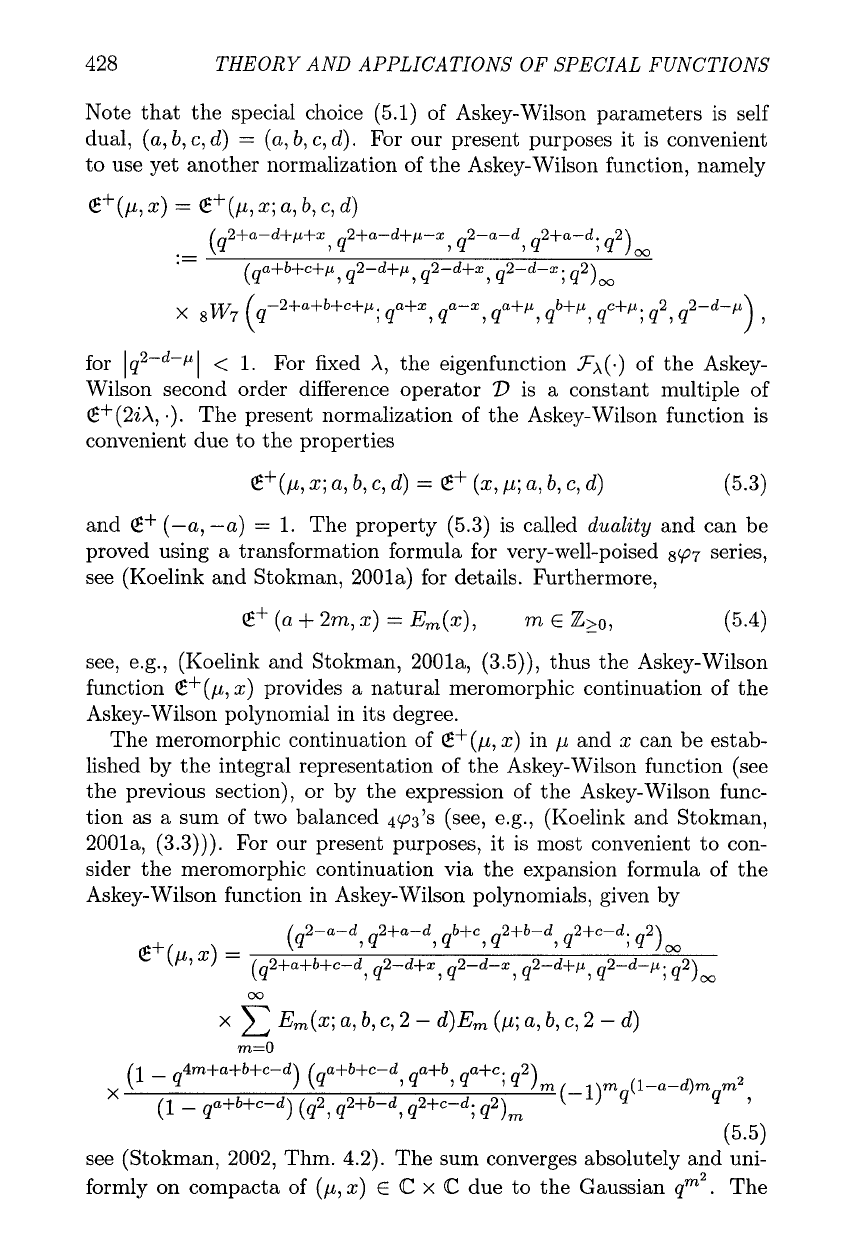
428
THEORY AND APPLICATIONS OF SPECIAL FUNCTIONS
Note that the special choice (5.1) of Askey-Wilson parameters is self
dual, (a,
b,
c, d)
=
(a,
b,
c, d). For our present purposes it is convenient
to use yet another normalization of the Askey-Wilson function, namely
for
lq2-d-pI
<
1.
For fixed
A,
the eigenfunction
.FA(-)
of the Askey-
Wilson second order difference operator
D
is a constant multiple of
&+(2iX,
.).
The present normalization of the Askey-Wilson function is
convenient due to the properties
and
&+
(-a, -a)
=
1.
The property (5.3) is called duality and can be
proved using a transformation formula for very-well-poised
897
series,
see (Koelink and Stokman, 2001a) for details. Furthermore,
see, e.g., (Koelink and Stokman, 2001a, (3.5)), thus the Askey-Wilson
function &+(p, x) provides a natural meromorphic continuation of the
Askey-Wilson polynomial in its degree.
The meromorphic continuation of &+(p, x) in p and x can be estab-
lished by the integral representation of the Askey-Wilson function (see
the previous section), or by the expression of the Askey-Wilson func-
tion
as
a sum of two balanced
493'~
(see, e.g., (Koelink and Stokman,
2001a, (3.3))). For our present purposes, it is most convenient to con-
sider the meromorphic continuation via the expansion formula of the
Askey-Wilson function in Askey-Wilson polynomials, given by
.
,
see (Stokman, 2002, Thm. 4.2). The sum converges absolutely and uni-
formly on compacta of (p, x)
E
C
x
C
due to the Gaussian
qm2.
The
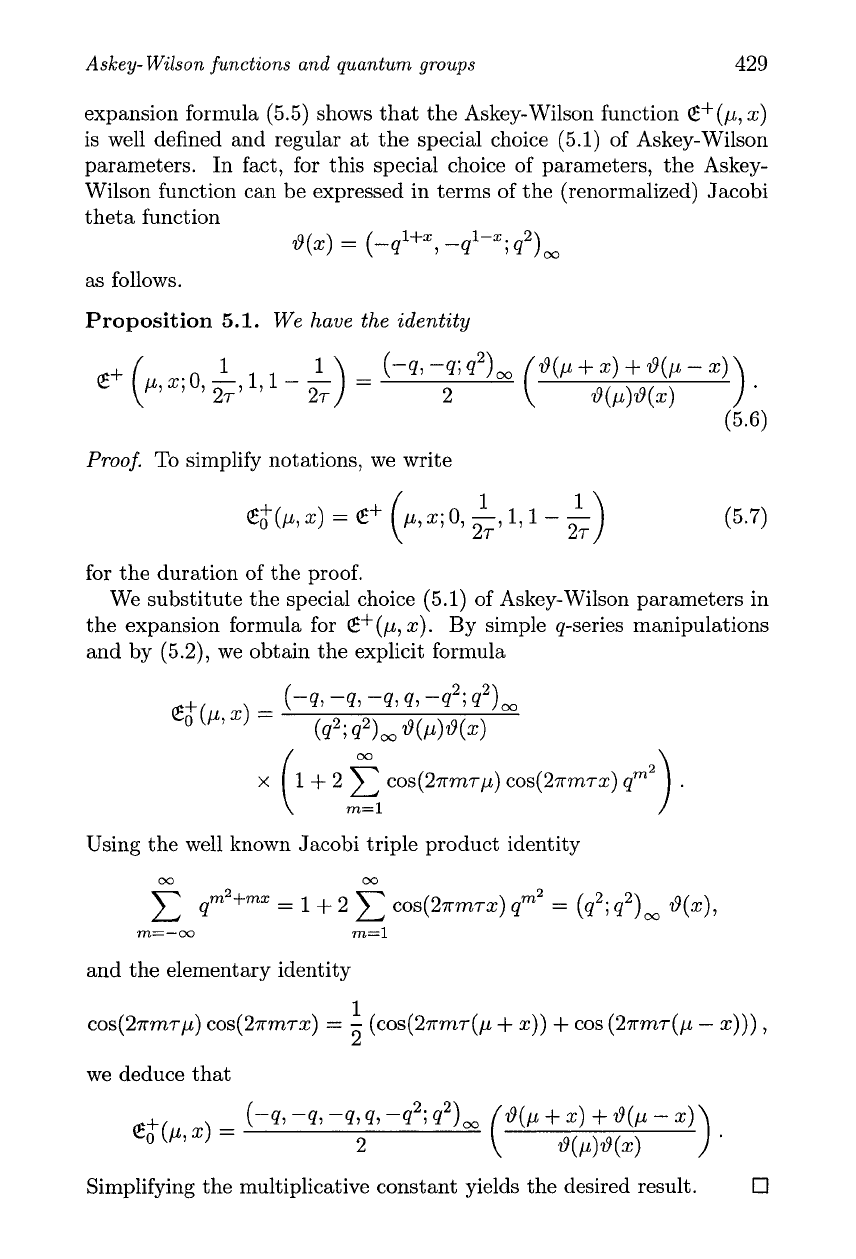
Aslcey- Wilson functions and quantum groups
429
expansion formula (5.5) shows that the Askey-Wilson function @(p, x)
is well defined and regular at the special choice (5.1) of Askey-Wilson
parameters. In fact, for this special choice of parameters, the Askey-
Wilson function can be expressed in terms of the (renormalized) Jacobi
theta function
d
(x)
=
(-ql+",
-ql-" ;
q2)
,
as
follows.
Proposition
5.1.
We have the identity
Proof.
To simplify notations, we write
for the duration of the proof.
We substitute the special choice (5.1) of Askey-Wilson parameters in
the expansion formula for @(p, x). By simple q-series manipulations
and by (5.2)) we obtain the explicit formula
Using the well known Jacobi triple product identity
and the elementary identity
1
cos(2~mrp) cos(2nmrx)
=
-
(cos(2?rmr(p
+
x))
+
cos (2?rmr(p
-
x)))
,
2
we deduce that
Simplifying the multiplicative constant yields the desired result.
0
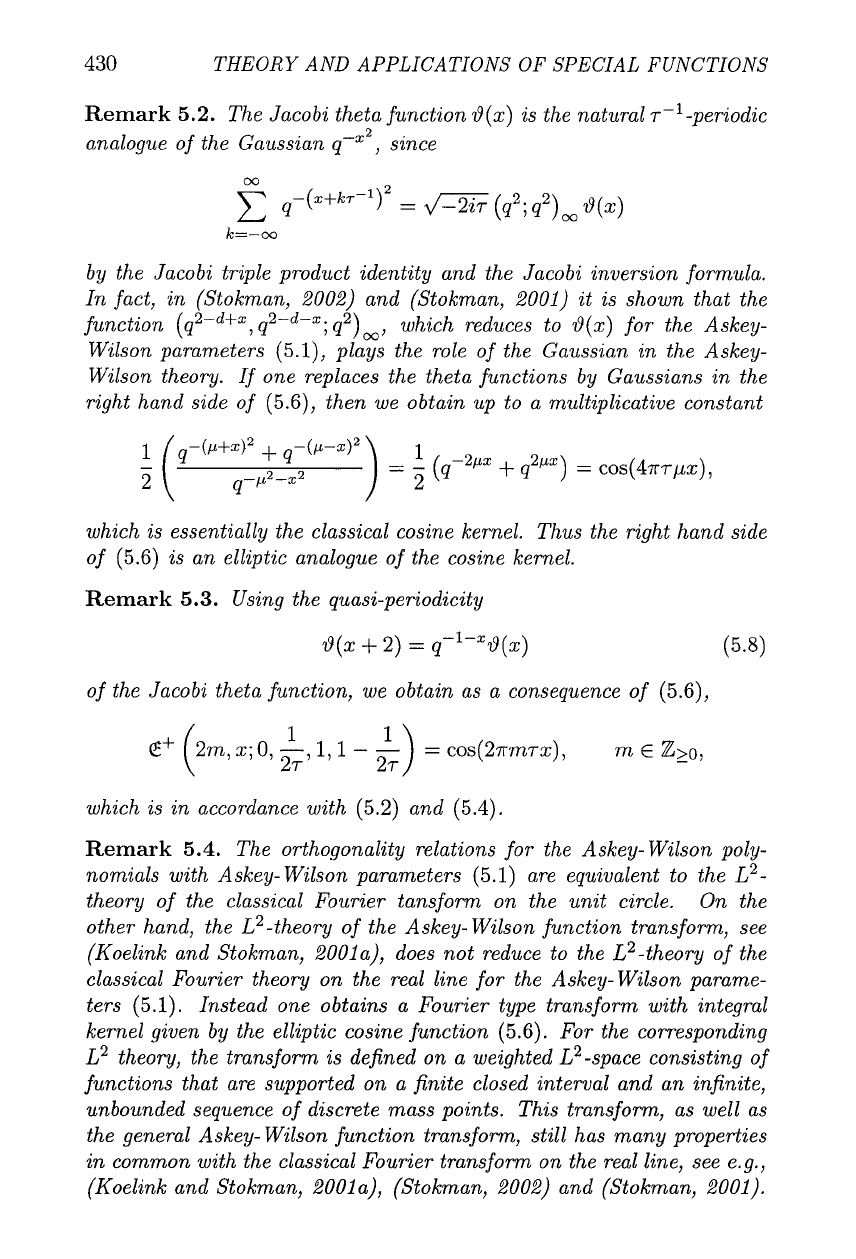
430
THEORY AND APPLICATIONS OF SPECIAL FUNCTIONS
Remark
5.2.
The Jacobi theta function 6(x) is the natural ~-'-~eriodic
analogue of the Gaussian since
by the Jacobi triple product identity and the Jacobi inversion formula.
In fact,
in
(Stokman, 2002) and (Stokman, 2001) it is shown that the
function
(q2-d+x, q2-d-x;
q2)_, which reduces to 6(x) for the Askey-
Wilson parameters (5.1), plays the role of the Gaussian
in
the Askey-
Wilson theory. If one replaces the theta functions by Gaussians
in
the
right hand side of (5.6), then we obtain up to a multiplicative constant
which is essentially the classical cosine kernel. Thus the right hand side
of (5.6) is an elliptic analogue of the cosine kernel.
Remark
5.3.
Using the quasi-periodicity
of the Jacobi theta function, we obtain as a consequence of (5.6),
which is in accordance with (5.2) and (5.4).
Remark
5.4.
The orthogonality relations for the Askey- Wilson poly-
nomials with Askey- Wilson parameters (5.1) are equivalent to the L2-
theory of the classical Fourier tansform on the unit circle. On the
other hand, the L2-theory of the Askey- Wilson function transform, see
(Koelink and Stokman, 2OOla), does not reduce to the L2-theory of the
classical Fourier theory on the real line for the Askey- Wilson parame-
ters (5.1). Instead one obtains a Fourier type transform with integral
kernel given by the elliptic cosine function (5.6). For the corresponding
L2 theory, the transform is defined on a weighted L2-space consisting of
functions that are supported on a finite closed interval and an infinite,
unbounded sequence of discrete mass points. This transform, as well as
the general Askey- Wilson function transform, still has many properties
in
common with the classical Fourier transform on the real line, see e.g.,
(Koelink and Stokman, 2001a), (Stokman, 2002) and (Stokman, 2001).
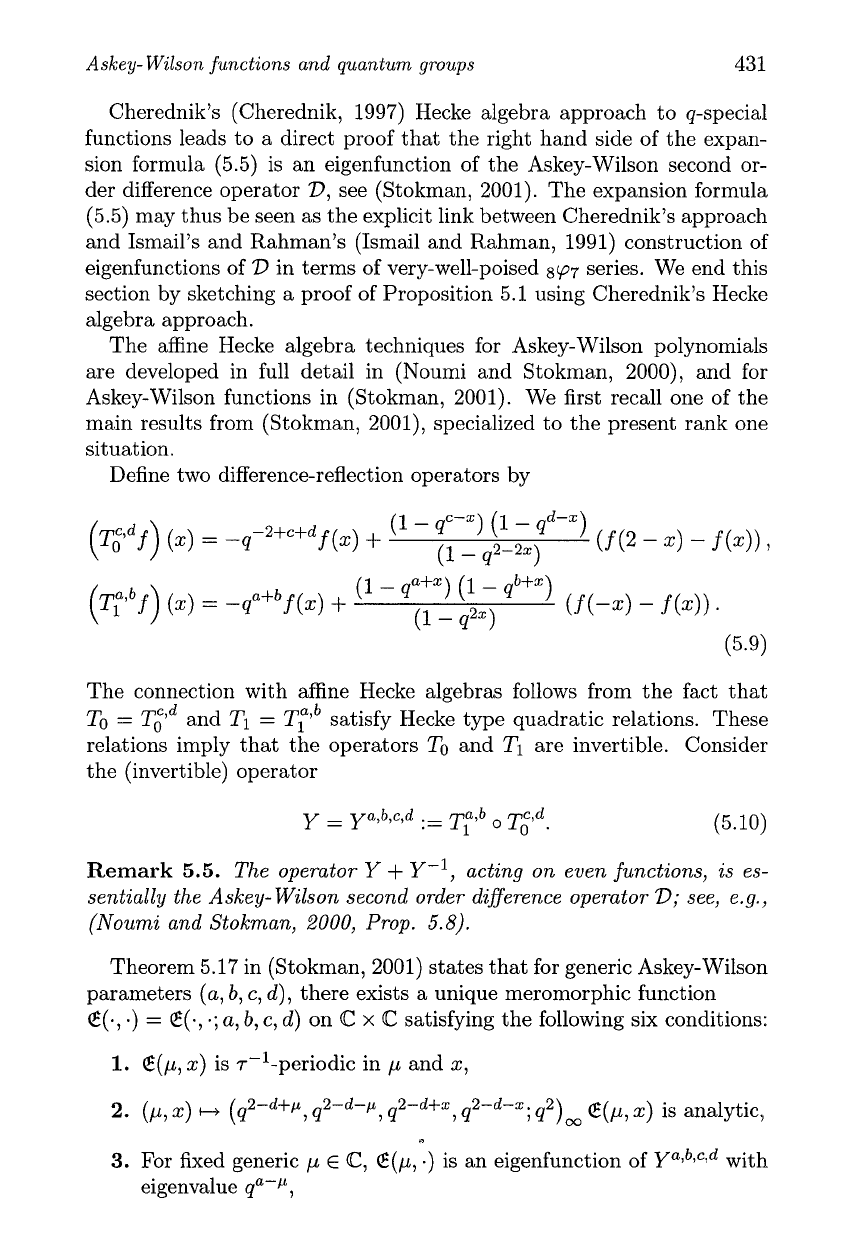
Aslcey- Wilson functions and quantum groups
431
Cherednik's (Cherednik, 1997) Hecke algebra approach to q-special
functions leads to a direct proof that the right hand side of the expan-
sion formula (5.5) is an eigenfunction of the Askey-Wilson second or-
der difference operator V, see (Stokman, 2001). The expansion formula
(5.5) may thus be seen as the explicit link between Cherednik's approach
and Ismail's and Rahman's (Ismail and Rahman, 1991) construction of
eigenfunctions of
D
in terms of very-well-poised
897
series. We end this
section by sketching a proof of Proposition 5.1 using Cherednik's Hecke
algebra approach.
The affine Hecke algebra techniques for Askey-Wilson polynomials
are developed in full detail in (Noumi and Stokman, 2000), and for
Askey-Wilson functions in (Stokman, 2001). We first recall one of the
main results from (Stokman, 2001)) specialized to the present rank one
situation.
Define two difference-reflection operators by
(1
-
qa+")
(1
-
qb+')
(2'~~~
f)
(x)
=
-qa+bf (x)
+
(1
-
q2")
(f
(-4
-
f
(4)
.
The connection with affine Hecke algebras follows from the fact that
To
=
T:~
and TI
=
T:'~
satisfy Hecke type quadratic relations. These
relations imply that the operators To and TI are invertible. Consider
the (invertible) operator
Remark
5.5.
The operator
Y
+
Y-I, acting on even functions, is es-
sentially the Askey- Wilson second order difference operator V; see, e.g.,
(Noumi and Stokman, 2000, Prop.
5.8).
Theorem 5.17 in (Stokman, 2001) states that for generic Askey-Wilson
parameters (a,
b,
c,
d),
there exists a unique meromorphic function
&(.,
a)
=
@(.,
.;
a,
b,
c, d) on
@
x
@
satisfying the following six conditions:
@(p, x) is ~-'-~eriodic
in
p and x,
(p,
x)
(q2-d+p,
q2-d-p
,
q 2-d+x,
q2-d-~
2
;q
Irn
&(p, x) is analytic,
0
For fixed generic p
E
@,
E(p,
.)
is an eigenfunction of
~~!~l~3~
with
eigenvalue qa-p,

432
THEORY AND APPLICATIONS OF SPECIAL FUNCTIONS
4.
For fixed generic x
E
@,
&(.,
x) is an eigenfunction of
~~y~,~,~
with
eigenvalue qa-"
,
5.
(rpb&(p,
.))
(x)
=
-cia+)
(T;?"(.,x)) (p),
The existence of a kernel
&
satisfying the above six conditions is proved
by explicitly constructing
&
as
series expansion in nonsymmetric ana-
logues of the Askey-Wilson polynomials, see (Stokman, 2001, (6.6)).
This expansion formula for
&
is very similar to the expansion formula
(5.5) of the Askey-Wilson function
&+
in Askey-Wilson polynomials. In
fact, a comparison of the formulas leads to the explicit link
see (Stokman, 2001, Thm. 6.20). These results allow us to study the
Askey-Wilson function
&+
using the characterizing conditions
1-6
for
the underlying kernel
&,
instead of focussing on the explicit expression
for
&+.
The kernel &(p,
x)
is regular at the Askey-Wilson parameters (5.1).
The resulting kernel
is the unique meromorphic kernel satisfying the six conditions
1-6
for
the special Askey-Wilson parameters (5.1). Observe that the operators
To, TI and
Y
for the special Askey-Wilson parameters (5.1) reduce to
hence Eo is the unique meromorphic kernel satisfying the six conditions
1'.
Eo(p, x) is ~-l-~eriodic in p and x,
2'.
(p, x)
H
6(p)6(x)
C0
(p,
x)
is analytic,
3'.
@o(p, x
+
2)
=
q-%(p, x),
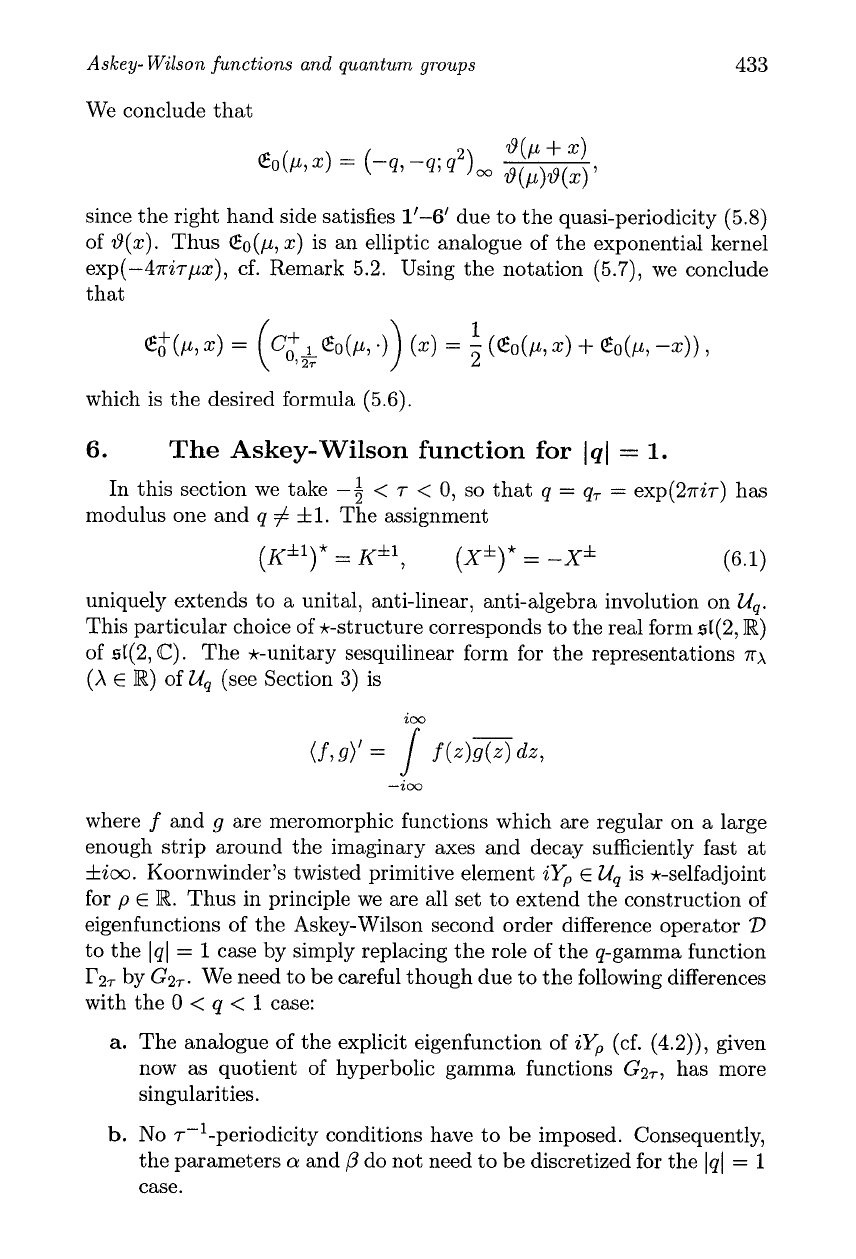
Askey- Wilson functions and quantum groups
We conclude that
since the right hand side satisfies
1'-6'
due to the quasi-periodicity (5.8)
of 29(x). Thus eo(p, x) is an elliptic analogue of the exponential kernel
exp(-4ni~px), cf. Remark 5.2. Using the notation (5.7)' we conclude
that
which is the desired formula
(5.6).
6.
The
Askey-Wilson function for
Iql
=
1.
In this section we take
-$
<
T
<
0,
SO
that q
=
q,
=
exp(2ni~) has
modulus one and q
#
f
1.
The assignment
uniquely extends to a unital, anti-linear, anti-algebra involution on
Uq.
This particular choice of *-structure corresponds to the real form sI(2, R)
of 42,
C).
The *-unitary sesquilinear form for the representations nx
(A
E
R) of
Uq
(see Section 3) is
ico
where
f
and
g
are meromorphic functions which are regular on a large
enough strip around the imaginary axes and decay sufficiently fast at
f
ioo. Koornwinder's twisted primitive element iYp
E
Uq
is *-selfadjoint
for
p
E
R. Thus in principle we are all set to extend the construction of
eigenfunctions of the Askey-Wilson second order difference operator
D
to the 141
=
1
case by simply replacing the role of the q-gamma function
F2,
by G2,. We need to be careful though due to the following differences
with the
0
<
q
<
1
case:
a.
The analogue of the explicit eigenfunction of iYp (cf. (4.2)), given
now as quotient of hyperbolic gamma functions G2,, has more
singularities.
b.
No ~-l-~eriodicity conditions have to be imposed. Consequently,
the parameters
a
and
,8
do not need to be discretized for the Iql
=
1
case.
